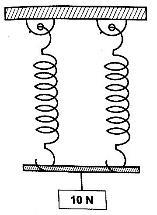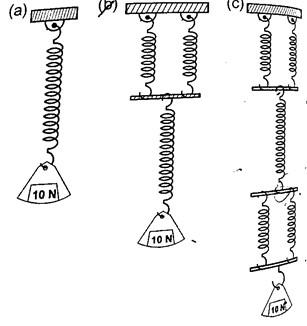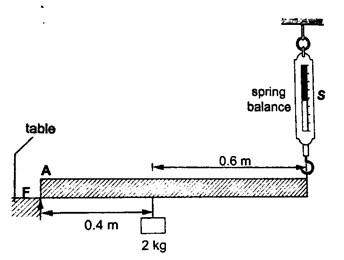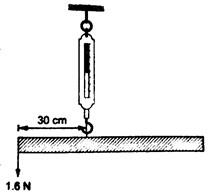-
Two identical springs, whose spring constant is 6.0 N/cm, are used to support a load of 60 N as shown below. Determine the extension of...
(Solved)
Two identical springs, whose spring constant is 6.0 N/cm, are used to support a load of 60 N as shown below. Determine the extension of each spring.

Date posted:
October 12, 2018
.
Answers (1)
-
A body of 200 g was hung from the lower end of a spring which obeys Hooke’s law. Given that the spring extended by...
(Solved)
A body of 200 g was hung from the lower end of a spring which obeys Hooke’s law. Given that the spring extended by 100 mm, what is the spring constant for this spring?
Date posted:
October 12, 2018
.
Answers (1)
-
A load of 4 N causes a certain copper wire to extend by 1.0 mm. Find the load that will cause a 3.2 mm extension...
(Solved)
A load of 4 N causes a certain copper wire to extend by 1.0 mm. Find the load that will cause a 3.2 mm extension on the same wire. (Assume Hooke’s law is obeyed).
Date posted:
October 12, 2018
.
Answers (1)
-
If the springs shown below are similar and the constant of proportionality (k) is 100 Nm-1, determine total extension in each arrangement.
(Solved)
If the springs shown below are similar and the constant of proportionality (k) is 100 Nm-1, determine total extension in each arrangement.

Date posted:
October 12, 2018
.
Answers (1)
-
Applications of the force on a conductor
(Solved)
Applications of the force on a current carrying conductor.
Date posted:
October 12, 2018
.
Answers (1)
-
State the factors affecting the magnitude of the force on a current carrying conductor
(Solved)
State the factors affecting the magnitude of the force on a current carrying conductor
Date posted:
October 12, 2018
.
Answers (1)
-
What is an electromagnet?
(Solved)
What is an electromagnet?
Date posted:
October 12, 2018
.
Answers (1)
-
Magnetic field due to solenoid
(Solved)
Magnetic field due to solenoid
Date posted:
October 12, 2018
.
Answers (1)
-
Rules for determining the direction of the lines of force
(Solved)
Rules for determining the direction of the lines of force.
Date posted:
October 12, 2018
.
Answers (1)
-
A vertical object 5 cm high is placed 10 cm in front of a convex mirror of focal length 15 cm. find the position, size...
(Solved)
A vertical object 5 cm high is placed 10 cm in front of a convex mirror of focal length 15 cm. find the position, size and nature of image formed. Determine the magnification of the image.
Date posted:
October 12, 2018
.
Answers (1)
-
Determine the size, position and nature of the image of an object 5.0 cm tall, placed on the principal axis of a concave mirror of...
(Solved)
Determine the size, position and nature of the image of an object 5.0 cm tall, placed on the principal axis of a concave mirror of focal length 15 cm, at a distance 35 cm from the mirror.
Date posted:
October 12, 2018
.
Answers (1)
-
State the applications of curved reflectors
(Solved)
State the applications of curved reflectors
Date posted:
October 12, 2018
.
Answers (1)
-
Location of images using ray diagrams
(Solved)
Location of images using ray diagrams.
Date posted:
October 12, 2018
.
Answers (1)
-
What are parabolic mirrors?
(Solved)
What are parabolic mirrors?
Date posted:
October 12, 2018
.
Answers (1)
-
Name the parts of a spherical mirror
(Solved)
Name the parts of a spherical mirror.
Date posted:
October 12, 2018
.
Answers (1)
-
Illustrate concave and convex mirrors with aid of diagrams
(Solved)
Illustrate concave and convex mirrors with aid of diagrams
Date posted:
October 12, 2018
.
Answers (1)
-
Explain three states of equilibrium with aid of diagrams
(Solved)
Explain three states of equilibrium with aid of diagrams.
Date posted:
October 12, 2018
.
Answers (1)
-
Define the term stability
(Solved)
Define the term stability
Date posted:
October 12, 2018
.
Answers (1)
-
A uniform rod is 1.0 m long weighs 5 N. It is supported horizontally at one end by a spring and the other end rests...
(Solved)
A uniform rod is 1.0 m long weighs 5 N. It is supported horizontally at one end by a spring and the other end rests on a table as shown below. A mass of 2kg is hung from the rod as shown; determine,
a) Reading of the spring balance
b) Reaction force, F, from the table.

Date posted:
October 12, 2018
.
Answers (1)
-
A uniform rod of length 1.0 m is hung from a spring balance as shown and balanced in horizontal position by a force of 1.6...
(Solved)
A uniform rod of length 1.0 m is hung from a spring balance as shown and balanced in horizontal position by a force of 1.6 N. Determine; (a) The weight of the rod (b) Reading of the spring balance

Date posted:
October 12, 2018
.
Answers (1)